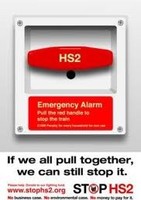TUNNELING
Years of construction work, if a surface HS2 route through Ealing is pursued:

HS2 Ltd have agreed to consider tunneling HS2 under North Ealing. They have also announced that all bridges through the Ealing London Borough section of the HS2 route would have to be
replaced if an overground HS2 route were constructed including BOTH bridges at Hanger Lane. Hanger Lane bridge replacement works themselves would take 3.5 years - causing huge chaos to the tens of
thousands of vehicles that use Hanger Lane on a daily basis.
The website Railway-Technical (http://www.railway-technical.com/finance.shtml) contains some comparative costings of various rail construction projects across the world. Approximately
half-way down the page is an entry for London's Crossrail: see below.
| Railway | Date | Equipment | Cost per km. | Length (kms.) | Comments |
|---|---|---|---|---|---|
| Angola: Luanda to Malanje | 2010 | Rehabilitation | $1.28million | 470 | |
| RFF France | 2010 | New double-track line | €35million | 1.2kms | |
| Crossrail, London | 2011 | New twin bore tunnels | £69million | 18kms | Tunnels only |
| Bremmer, Switzerland | 2011-16 | New twin bore tunnels | €109million | 55kms | |
| Spain | 2011 | Route doubling & Electrification | €2.125million | 26.4kms |
Crossrail has been costed at £69m per km yet HS2 Ltd of the opinion that tunnelling through 8km of Ealing would cost £45m per kilometre more (£360m divided by 8) than a surface route, even
though TfL believe the figure to be a £25m per km differential. However, if you take the ~£50m figure this suggests the proposed surface option would cost in the region of £24m per km (ie. £69m -
£45m) or £192m in total.
.
£360m however, fails to take into account the cost of bridge replacements (probably at least £100m) and tunnel portals - which cost about £100m each. Two tunnel portals achieved by tunnelling
all the way through LB Ealing would be eliminated by tunneling the section. This is a saving of £300m. This suggests the actual cost of tunnelling would be about £130m less than a surface
route.
.
Clearly HS2 Ltd's estimation of the incremental cost of a tunnel lacked credibility before and lacks even more credibility now.
.
If all the other additional expenses that would be associated with a surface line (i.e. property destruction, compensation, transport disruption, social, environmental and economic costs -
loss of opportunity costs and relocation costs) and add those to the cost of actually laying the track and associated infrastructure it is clear that in total the financial differential
will be considerably less than what is suggested.
.
The lifetime maintenance costs of a tunnelled route are also considerably less than an overground route.






